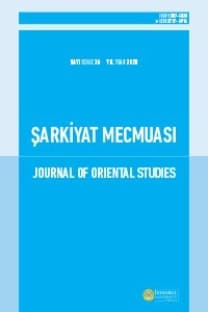Edebi Metin Çözümleme Yöntemi Olarak Alegorik Yorumlama Özelinde Zeyn’in Düğünü Romanının Bir Yorumu
Edebi Metin Çözümlemesi, Alegori, Alegorik Anlatı, Alegorik Yorumlama, Zeyn’in Düğünü
An Interpretation of the Novel The Wedding of Zein in the Specific of Allegorical Interpretation as Literary Text Analysis Method
Literary Text Analysis, Allegory, Allegorical Narrative, Allegorical Interpretation, The Wedding of Zein,
___
- Abbas, A. (1974). “Notes on Tayeb Salih: Season og Migration the The North and The Wedding of Zein”. Sudan Notes and Records, 55, 46-60. Retrieved March 30, 2021, from http://www.jstor.org/stable/42677954.
- Berkley, C. E. G. (1980). “El Tayeb Salih, The Wedding of Zein”. Journal of Arabic Literature, 11, 105-114. Retrieved March 30, 2021, from http://www.jstor.org/stable/4183036.
- Biblissima. ἀλληγορία. Retrieved January 17, 2021, from https://outils.biblissima.fr/en/eulexis-web/index.php.
- Britannica, T. Editors of Encyclopaedia (2021, February 14). Al-Ṭayyib Ṣāliḥ. Retrieved February 30, 2021 Encyclopedia Britannica, from https://www.britannica.com/biography/al-Tayyib-Salih.
- Derrida, J. (1988). Mémoires pour Paul de Man. Paris: Galilée.
- Dwds. allegorie. Retrieved January 18, 2021, from https://www.dwds.de/wb/Allegorie.
- Etyonline. allegoria. Retrieved January 18, 2021, from https://www.etymonline.com/search?q=allegoria.
- ________. *al. Retrieved January 22, 2021, from https://www.etymonline.com/word/*al-.
- ________. agora. Retrieved January 24, 2021, from https://www.etymonline.com/word/agora?ref=etymonline_crossreference.
- ________. allegory. Retrieved January 25, 2021, from https://www.etymonline.com/search?q=allegory.
- Hassan, W. S. (2003). Tayeb Salih: Ideology and the Craft of Fiction. Syracuse: Syracuse University Press.
- Hawley, J. C. (2001). Encyclopedia of Postcolonial Studies. London: Greenwood Press.
- Liddell, H. G., Scott, R. (1940). A Greek-English Lexicon. London: Oxford University Press.
- Man, P. de (1983). The Retoric of Temporality. Minnesota: University of Minnesota Press.
- Partridge, E. (2006). Origins A Short Etymological Dictionary Of Modern English. e-Library: Taylor & Francis.
- Plato. (1991). The Republic of Plato. (Allon B. Trans.). New York: Basic Books.
- Salih, T. (1997). Urs Al-Zein, Beirut: Dar Al-Ceal.
- Salih, T. (2011). The Wedding of Zein And Other Stories. (D. Johnson-Davies, Trans.). New York: New York Review Books.
- Whitman, J. (1987). Allegory. Cambridge: Harward University Press.
- ISSN: 1307-5020
- Yayın Aralığı: 2
- Başlangıç: 1956
- Yayıncı: İstanbul Üniversitesi Edebiyat Fakültesi Şarkiyat Araştırma Merkezi
Arap Şiirinde Zaruretten Kaynaklanan Ziyadeler
Yahyâ b. Saîd el-Antâkî’nin Târîh’inde Bahrî Seferler, Denizcilik ve Nil Nehri
İntizar Hüseyin’in Öykü Yazarlığı
Çağdaş Bir Ebû Tâlib: Reşîd Selîm el-Hûrî (Korku ve Kompleks)
Emevi Döneminde Ahlaki Şiirde İç Kafiyelerin Tezahürleri: Teknik Bir Çalışma
Edebi Metin Çözümleme Yöntemi Olarak Alegorik Yorumlama Özelinde Zeyn’in Düğünü Romanının Bir Yorumu
Musul Atabeglerinin Meşhur Devlet Adamı: Cemâleddin el-İsfahânî (ö. 559/1164)
İran Mitolojisi Üzerine Bir Okuma: Sîmîn Dânişver’in Sevûşûn Adlı Romanı
Kur’ân-ı Kerim’de Geçen İhkâm ve İtkân Lafızları Arasındaki Anlam Farklılıkları
Sâdık Bey Afşâr’ın Mecma‘ü’l-Havâs Neşri Üzerine Gelen Eleştirilerin İncelenmesi
